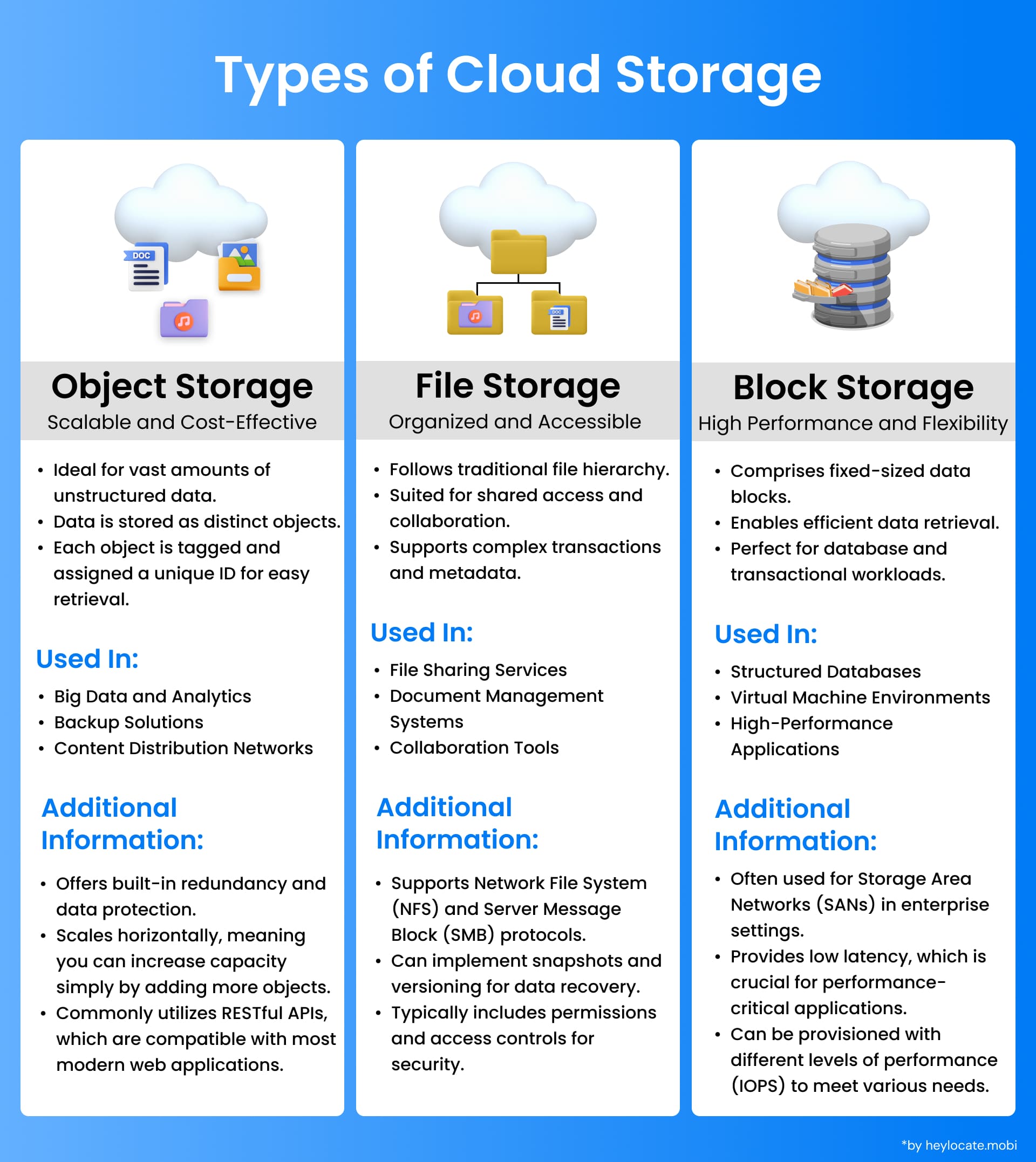Cloud Storage
What is Cloud Storage?
Cloud storage is a remote data storage model where data is securely housed on multiple servers managed by cloud service providers. Unlike traditional storage methods such as hard drives or physical servers, cloud storage enables users to seamlessly store, retrieve, and manage their data from anywhere over the internet.
Key Features
A hallmark feature of cloud storage is its unparalleled scalability. Cloud service providers furnish users with many storage plans, allowing them the flexibility to tailor their storage capacities to match their exact requirements. The pay-as-you-go model epitomizes cost-effectiveness, ensuring that users only pay for the storage they consume, thereby mitigating unnecessary expenditure. Furthermore, cloud storage boasts high availability and redundancy, courtesy of data replication across multiple servers. This redundancy ensures continuous accessibility to data, even in the unlikely event of server failure.
Another important aspect of cloud storage is its collaboration and file-sharing facilitation. Cloud storage platforms are replete with features that enable users to seamlessly share files with others through shareable links or granular access permissions. This collaborative ethos fosters synergy among teams, enabling them to work cohesively on projects, with files being accessible and editable in real time.
Access Methods and Usage
Cloud storage platforms offer users diverse access methods, catering to different preferences and needs.
| Access Method | Description | Compatibility |
|---|---|---|
| Web Browsers | Users can simply log in to their cloud storage accounts via a web browser, where they can upload, download, and manage their files | Any device with an internet connection |
| Desktop and mobile applications | A more immersive and integrated experience with an ability to synchronize files across devices: the changes made on one device are automatically reflected on other devices linked to the same cloud storage account | Any device; some apps often offer offline access, allowing users to view and edit files even when they’re not connected to the internet |
Applications and Industries
The ubiquity of cloud storage transcends individual users and permeates various industries and applications. For individuals, cloud storage serves as a repository for personal files, encompassing everything from cherished memories captured in photos and videos to critical documents and archives. It is a robust backup solution, safeguarding against data loss in the event of hardware failure or unforeseen disasters.
Businesses, on the other hand, harness cloud storage’s power for many purposes, from data backup and archival to collaborative endeavors and employee file sharing. It empowers employees to access critical files from anywhere, thereby fostering productivity and flexibility.
Understanding the Architecture
Cloud storage has a sophisticated architecture built upon virtualized infrastructure. Cloud service providers abstract and manage physical hardware resources, providing users with unparalleled flexibility and scalability. It is imperative to delineate cloud storage from cloud computing, with the former focusing exclusively on data storage. Various storage types abound within cloud storage, including object storage, file storage, and block storage, each catering to distinct use cases and storage requirements.

Benefits for Businesses and Individuals
The benefits bestowed by cloud storage are manifold and far-reaching. From a business standpoint, cloud storage epitomizes cost efficiency and scalability, enabling organizations to scale their storage needs with their data growth without the burden of managing physical storage infrastructure. Accessibility is another crucial benefit, empowering individuals and teams to collaborate seamlessly, irrespective of geographical boundaries. Moreover, cloud storage is a linchpin in disaster recovery plans, ensuring business continuity in adversity.
From an environmental perspective, cloud storage exerts a positive influence under its energy efficiency and reduced carbon footprint. Cloud providers operate large-scale data centers that are inherently more energy-efficient than individual storage devices, contributing to a greener, more sustainable future.
References
- “A History of Cloud Computing”. ComputerWeekly.
- Louden, Bill (September 1983). “Increase Your 100’s Storage with 128K from Compuserve”. Portable 100. New England Publications Inc. 1 (1): 22.
- What is Cloud Storage & How Does it Work? | Google Cloud
- Cloud storage – Wikipedia
- What is Cloud Storage? | IBM
- What is Cloud Storage?
- What is cloud storage? | Cloudflare